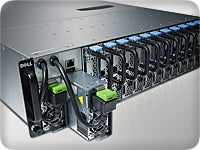First there were mainframes that filled cavernous halls. Mainframes gradually slimmed down and standardized over the course of many years, and we arrived at the rack server. These servers were followed by pizza box-sized servers and blades.
Now we have tiny microservers threatening to become the next great server form factor, and Dell is pushing them hard with the recent release of its third generation of microserver.
The latest release is the Dell PowerEdge C5220, which uses Intel Xeon processor E3-1200v2 processors based on 22nm manufacturing technology. The PowerEdge C5220 includes features such as 17 Watt and 45 Watt versions, DDR3-1600 memory speeds, ECC memory, 64-bit processing, Intel VT-x and shared power and cooling.
 “Our first generation was based upon a VIA CPU and a custom design for a very large hosting company in Europe,” said Drew Schulke, Data Center Solutions Marketing Director at Dell. “As we looked to take microservers beyond a small number of customers into the broader market, we knew we would have to increase their capability.”
“Our first generation was based upon a VIA CPU and a custom design for a very large hosting company in Europe,” said Drew Schulke, Data Center Solutions Marketing Director at Dell. “As we looked to take microservers beyond a small number of customers into the broader market, we knew we would have to increase their capability.”
Schulke explained that the partnership with Intel has helped evolve the microserver market to address a wider range of challenges by increasing density and power efficiency. The C5220, for example, delivers up to 1.95 times more performance within the same rack compared to the previous generation of microservers using early Xeon chips.
“The ability to produce a sub-20 Watt part is very compelling,” said Schulke. “You now have an enterprise-capable server that is consuming a fraction of the power of a more traditional server. In the microserver space it translates into more compute for every rack in the data center — reducing operating costs and delaying new data center capital costs.”
These microservers fit inside a Dell C5000 chassis, with support for up to 12 micros in one chassis. While you can run with just a single server inside, they come with a minimum of four servers included per chassis. Pricing for the PowerEdge C5220 starts at $12,207.84 for one chassis with eight microservers.
Market Segment
Just as the appearance of blades did not mean that every single application needed to be moved from racks or towers onto blades, so it is with micros. Microservers are better for certain uses than others. Where do they make most sense?
“For companies with a large Web farm running a LAMP stack, the performance per Watt associated with a microserver architecture is attractive,” said Schulke. “In other scenarios like the High Performance Computing (HPC) space, we find customers have applications that run best in single-socket environments, but require thousands of cores. In scenarios like these that demand density and power efficiency, microservers are equally compelling.”
Other business use cases are Web 2.0, cloud and content delivery networks (CDN). A case in point is a company called Morphlabs that uses the PowerEdge C5220 for its mCloud Rack Enterprise Edition private cloud, which is offered by the company’s service provider partners and is based on Solid State Drive (SSD) technology.
“Morphlabs works closely with Dell to power our all-SSD mCloud Rack,” said Winston Damarillo, founder and CEO of Morphlabs. “Upgrading to Dell’s newest microserver enables us to deliver hardware-level isolation for private clouds that can then be clustered together to form a resilient platform for mission-critical workloads.”
Dell reports that an online media group has deployed PowerEdge C5220 servers to reduce cost and drive growth. Each micro supports up to 50 percent more users than the group’s previous servers, enabling consolidation of its server footprint by a ratio of 4:1, while supporting a Web 2.0 software infrastructure consisting of Linux, Apache, MySQL and PHP software. Another company in the oil and gas industry uses the C5220 to run software for seismic data processing and imaging.
On the CDN side, a firm known Vibrant Media is another fan of Dell microservers. “We are reaching more than 250 million users per month with our contextual in-text, in-image, display and video advertising solutions,” said Ben Anderson, vice president, global operations & IT at Vibrant Media. “Dell’s PowerEdge C5220 platform has provided us with a cost-effective, scalable platform to support our 6,500 publishers.”
So will microservers conquer the world? Maybe, maybe not. But the history of computing reveals a steady diminishing in component and server size, so their ascendency is likely.
“More users are taking a close look at their applications and considering compute options optimized around that,” said Schulke. “We are already seeing this in hyperscale customers where decisions like this have huge impacts on the efficiency of their operations.”
Drew Robb is a Los Angeles-based freelancer specializing in all aspects of technology, engineering and renewable energy. Born and raised in Scotland, he received a degree in Geology/Geography from the University of Strathclyde, Glasgow.

